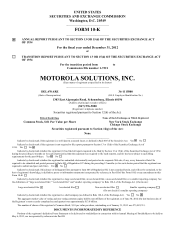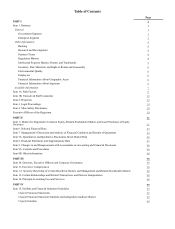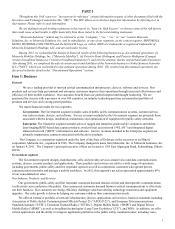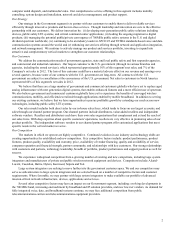Motorola 2012 Annual Report Download - page 12
Download and view the complete annual report
Please find page 12 of the 2012 Motorola annual report below. You can navigate through the pages in the report by either clicking on the pages listed below, or by using the keyword search tool below to find specific information within the annual report.
4
Other Information
Backlog
During 2012, we changed our methodology for reporting backlog. Prior to the first quarter of 2012, we excluded from
backlog service orders such as maintenance and extended warranty contracts. Additionally, certain product and system
installation labor orders that were for delivery beyond a certain time frame, typically 18 months, were excluded from backlog.
Our new methodology now includes all service, product, and system installation orders that have been received, and are
believed to be firm.
The Company’s backlog, using our new methodology for both years, as of December 31, 2012 and December 31, 2011
was as follows:
December 31
(In millions) 2012 2011
Government $ 4,937 $ 4,426
Enterprise 782 875
$ 5,719 $ 5,301
Approximately 40% of the Government backlog and 85% of the Enterprise backlog is expected to be recognized as
revenue during 2013. The forward-looking estimate of the firmness of such orders is subject to future events that may cause
the amount recognized to change.
Research and Development
We participate in very competitive industries with constant changes in technology. Throughout our history, we have
relied, and continue to rely, primarily on our research and development (“R&D”) programs for the development of new
products, and on our production engineering capabilities for the improvement of existing products. We supplement our internal
R&D spending through activities with joint development and manufacturing partners. Management believes, looking forward,
that our commitment to R&D programs should allow us to remain competitive.
R&D expenditures relating to new product development or product improvement were $1.1 billion in 2012, compared to
$1.0 billion in 2011 and in 2010. We continue to believe that a strong commitment to R&D is required to drive long-term
growth. As of December 31, 2012, we had approximately 7,000 professional employees engaged in such R&D activities.
Payment Terms
Payment terms vary worldwide, depending on the arrangement. Generally, contract payment terms range from 30 to
45 days from the invoice date within North America and typically do not exceed 90 days in regions outside of North America.
A portion of the contracts within our Government segment include implementation milestones, such as delivery, installation
and system acceptance, which generally take 30 to 180 days to complete. Invoicing the customer is dependent on completion of
the milestone.
We generally do not grant extended payment terms. As required for competitive reasons, we may provide long-term
financing in connection with equipment purchases. Financing may cover all or a portion of the purchase price.
Regulatory Matters
The use of wireless voice, data and video communications systems requires radio spectrum, which is regulated by
governmental agencies throughout the world. In the U.S., the Federal Communications Commission (“FCC”) and the National
Telecommunications and Information Administration (“NTIA”) regulate spectrum use by non-federal entities and federal
entities, respectively. Similarly, countries around the world have one or more regulatory bodies that define and implement the
rules for use of the radio spectrum, pursuant to their respective national laws and international coordination under the
International Telecommunications Union (“ITU”). We manufacture and market products in spectrum bands already made
available by regulatory bodies. These include voice and data infrastructure, mobile radios and portable or handheld devices.
Consequently, our results could be positively or negatively affected by the rules and regulations adopted from time to time by
the FCC, NTIA or regulatory agencies in other countries. Our products operate both on licensed and unlicensed spectrum. The
availability of additional radio spectrum may provide new business opportunities, and consequently, the loss of available radio
spectrum may result in the loss of business opportunities. Regulatory changes in current spectrum bands may also provide
opportunities or may require modifications to some of our products so they can continue to be manufactured and marketed.
As television transmission and reception technology transitions from analog to more efficient digital modes, various
countries around the world are examining, and in some cases already pursuing, the redevelopment of portions of the television
spectrum. In the U.S., pursuant to federal legislation, analog television stations ceased operation in the broadcast television
























